Amazing and frightening
View(s):Last month three young professionals from Sri Lanka became some of the select few to visit the Antarctic Peninsula. In this exclusive interview with Duvindi Illankoon, they speak about their decision to travel to the last wilderness on Earth, and the incredible-and often devastating-sights that greeted them
A voyage that has opened his eyes
They say seeing is believing. For 27-year-old Shamal Boyagoda, seeing and believing involved a longer journey than for most. Operations Manager at MAS Intimates Unichela by day and loving parent to adorable tot Aanya along with wife Salini, the hefty former oarsman from Royal College defies expectations of the tree-hugging, slogan-chanting environmentalist one would expect. “I’ve never been particularly passionate about global warming or the environment,” he admits ruefully. “I’d never intentionally do anything to harm the environment, but then again I didn’t go out of my way to help either.”
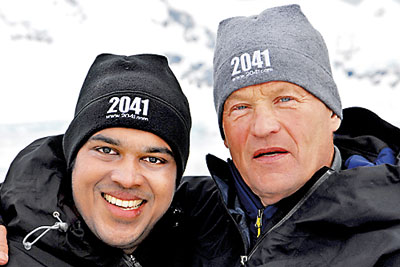
Shamal with Sir Rob
A not-so-chance encounter with Sir Rob Swan changed things. British born Robert Swan (OBE) is the first person to walk to both the North and South Poles. He set up his company 2041 (www.2041.com) with the aim of building up an influential network to protect the Antarctic Treaty (which regulates international relations with regards to the Antarctic) as it is set to be renegotiated in 2041. The treaty protects Antarctica, an unclaimed territory, from exploitation.
Sir Rob was in Sri Lanka last November, where he issued an open invitation to companies to send representatives for an Antarctic Expedition. Shamal, inspired by his words, volunteered to go when MAS offered the opportunity to its employees. “I remember telling the selection committee that I wanted to go because I needed to see with my own eyes if I am to believe,” he remembers. “I said if I go, and I see for myself firsthand the effect of our actions on the South Pole, then I could come back and apply myself to changing how we do things here.” MAS, a pioneer in industry sustainability in the country, were suitably impressed and gave Shamal the go ahead to get ready for the expedition.
Shamal, together with his fellow Sri Lankan counterparts Nishadi Malalgoda and Praneeth Mendis who were also travelling to the Antarctic, landed in Buenos Aires, Argentina on February 28. From here they travelled to Ushuaia. Over the next three days they met their team mates-80 individuals from 28 countries- and were briefed on everything they would need to know about travelling to the Antarctic.
The Antarctic continent is one of the most remote, inhospitable environments on earth. Harsh and inaccessible, covered by over 5 million square miles of solid ice, it is the world’s highest, driest, coldest and windswept continent. ?Which means there are a lot of different things that can go wrong if you don’t know what you’re doing,” quips Shamal. Thanks to his athletic background as an oarsmen and cricketer, coupled with plenty of outdoor experience as a President’s Scout, he was well suited for the expedition. “There was a lot to learn, though. From layering (four layers of clothes), to safety mechanisms, to the self-arrest procedure (how to look after yourself and your team mates in face of adversity) and our diet we were thoroughly briefed by a team of experts.”
They set off on the cruise ship ‘Sea Spirit’ on the fourth day, travelling through Drake Passage, the roughest sea in the world. Over the next two days, Shamal and his fellow explorers spent bonding time being violently sea-sick. Reaching the Antarctic Peninsula through the Lemaire Channel and seeing their first iceberg made everything fully worth it though, he smiles. “The ship was our base. Everyday we travelled to different islands using tiny boats called zodiacs, and returned in the evening.”
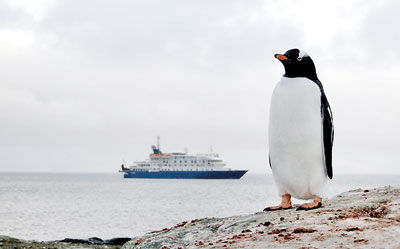
Surveying its kingdom: A lone penguin
The purpose of the expedition was to make them aware of the Antarctic’s condition-not to test their strength, he explains. It was only one night that they spent in sleeping bags under the starry Southern skies, ensconced in little dugouts in the snow for warmth. Most of their time was spent exploring the many islands of the terrain, being given guided tours by marine experts, historians and even Nobel Peace Prize winners.
He is still dumbfounded by the dramatic changes that the continent is undergoing. “This is one of the driest places on earth. So to see ice waterfalls-when there aren’t meant to be any-and witness icebergs crumbling and the many crevasses…that kind of stays with you.” They learnt that pollution inflicted by man-made agents reflected on the North and South Poles, in turn subtly altering the planet’s climate, with disastrous consequences on its way. “It was terrifying, but I fell in love with the Antarctic. Seeing the wildlife, learning its history and exploring the terrain and realising how important that landmass is to Earth’s existence was a revelation.”
He loved the one-on-one sessions they were often given with the man himself, Sir Rob. One thing he said really struck me-he asked what my purpose in life was, what my legacy was to be. That made an impact. It got me thinking of how I can make an impact back home with what we learnt on that voyage.”
Back in Colombo, he’s already set things in motion; Shamal and his team hope to set up a platform for sharing the industry’s best practices among corporates. “It shouldn’t be a competition as to who does it the smartest-we should share our different practices and knowledge amongst ourselves so everyone gets a piece of the cake. This planet belongs to all of us, after all.”
The stark beauty, it’s like nothing you’ll ever see
Nishadi Malalgoda found the penguins cute, but the smell was a little-well, horrendous. “They were the cutest things you’ll ever see,” she grins. “But the closer you got, the further you wanted to be away.”
Encountering the penguins-among others-in their natural habitat was just part and parcel of her Antarctic experience. When Sir Rob visited Millenium IT to talk to them about 2041 and issued an invitation for one individual to join the voyage, Nishadi knew she had to do it.
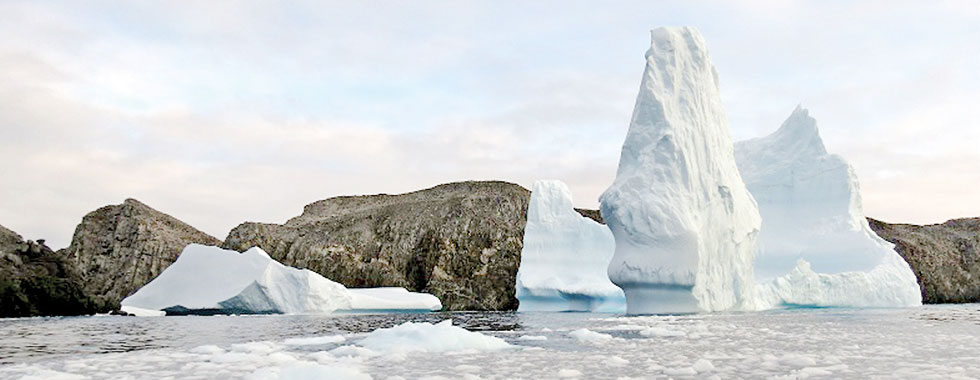
Pic by Nishadi Malalgoda
Nishadi, 30, a former student (and Head Prefect) of Sirimavo Bandaranaike Vidyalaya and an alumni of the University of Colombo, has always been a go-getter. “I’m not someone who’s content sitting around and waiting for things to happen. From my school days, I was the kid who put her hand up for everything!” She joined Millenium IT as a Senior Business Analyst in 2006, and has been heavily involved with charity work in her spare time.
In 2009, she took a break to study for her Masters in the UK, and got the opportunity to volunteer at an orphanage in Malawi for three months. It was an eye opener, she says. “I taught kids Maths and English. The experience was absolutely amazing. It got me even more hooked on giving back.” Since then, she made it a point to work with communities both locally and abroad. When she heard about 2041 and listened to Sir Rob, she knew that she had to get involved.
The next three months were a whirlwind. Nishadi applied for the opportunity successfully and went about making preparations. The most challenging was getting the visa for her trip, she grimaces. 2041 is a run from Argentina (Antarctica being unclaimed territory), and Sri Lanka doesn’t have an embassy for the country. All the relevant documents had to be couriered back and forth to India.
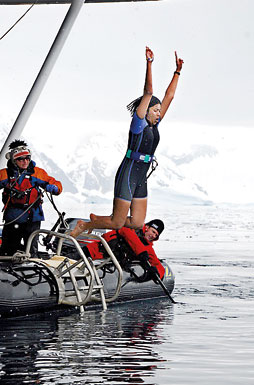
Braving the icy waters: Nishadi takes the plunge. Pic by John Luck
Once everything was in order and the other requirements for the trip sorted out, they travelled to Argentina and had three days of intense training and workshops in Ushuaia. Nishadi remembers a glacier hike in the town itself, where they came across the first signs of the impact of global warming on the southernmost hemisphere of the world. “All of Ushuaia gets water from the Marshall Glacier,” explains Nishadi. “Visiting this for a practice hike was a revelation, because you can see that the glacier is visibly shrinking. The town is very worried because they have no other way of accessing water.”
Once they left Ushuaia and sailed into the Antarctic islands, she was struck by the stark beauty of the terrain. “It’s like nothing you’ll ever see,” she says. As apt for the coldest place on earth, the voyagers were well wrapped up in four layers of clothing designed to keep the chill out-averaging at minus 58 F over the year.
To her dismay, Nishadi had to face up to her worst fears being confirmed. “You know back home-especially in Colombo-we hear about the effects of global warming in the South Pole and it doesn’t shock us the way it should. You need to actually go there to see how much the glaciers have retreated. On the ship we were shown pictures from about five or ten years ago and then we see the glacier for ourselves the difference is shocking.
I remember one time we were all called out onto the deck by Rob to see for ourselves a massive ice shelf that was breaking up and falling into the sea. The ice shelf was huge-can you imagine the sea level rising?” To put things into perspective, if global warming caused the Antarctic ice shelves to melt, the world’s oceans would rise by 60-65 metres everywhere. Antarctica holds about 70% of the Earth’s water in solid ice.
Her favourite was undoubtedly the Polar Plunge, reserved for the more daring members of the expedition. Taking a dive into the icy cold waters of the Southern Ocean wasn’t everyone’s cup of tea, but Nishadi had been looking forward to doing this since she had heard about it. “Of course, when I was actually standing there in my swimsuit, teeth chattering and the icy Antarctic wind all around me it was a different story,” she grins. “But I thought why not, and jumped in anyway. It was exhilarating.”
Back in Colombo, she is passionate about preserving the untamed beauty she witnessed in her expeditions. The Antarctic Treaty is up for renegotiation in 2041, and by that time these activists are hopeful of alternative sources of energy being in use. “The main premise of the treaty is to keep Antarctica as an unclaimed territory. It’s rumoured that there are 50 billion barrels worth of oil in the Antarctic. Can you imagine the wars that would break out in the world, trying to claim this? It’s important we develop and start adapting ourselves to alternative sources of energy,” she says. As part of her contribution, she hopes to kick-start an efficient waste management initiative.
Would she go there again, given half the chance? “Like a shot,” she smiles. “But I’m not returning till I feel I’ve done enough back home to further the cause. Once I’ve accomplished that, I can return without a guilty conscience.”
I heard the sound of glaciers breaking four times within an hour
Praneeth Mendis completes the trio of Antarctic explorers from Sri Lanka. An ardent lover of trekking, hiking and nature and wildlife photography, the southernmost terrain of the planet provided him with vivid landscapes and unbeatable scenery as a subject. “It’s through my travel and photography that I developed my connection with nature and became passionate about conserving the environment,” he enthuses. “I’ve seen so many beautiful waterfalls in Sri Lanka and I’m determined to ensure that future generations will have the same privilege I have had to experience and photograph their beauty.”
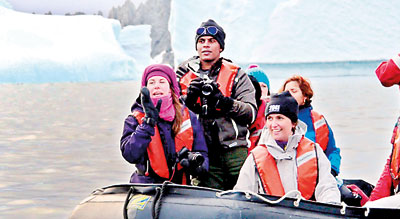
Praneeth with his camera: Not missing out on anything
A keen player of football, cricket, rugby and an athlete during his schooldays at Dankotuwa Sri Sanga Bodhi College, he’s a stickler for fitness and travel. Working in Finance at Coca-Cola Beverages Sri Lanka Praneeth doesn’t get too much opportunity to get knee-deep in the great outdoors. So when Sir Rob invited a Coca-Cola employee to join him on the expedition, Praneeth knew he had to do it.
“I first met him when he did a motivational speech to Coke employees on sustainability and leadership using his own experience in travelling to the South Pole,” he remembers. “I was really inspired by his story and experience.
I wondered if I could get a chance to go on the Antarctica expedition and spread the message about sustainability and leadership to my community during his inspiring speech.” Praneeth says he has always had a passion for community service as an active member of the company’s ‘Say We Care’ CSR initiative. No stranger to sustainability programmes, he’s also a member of the company’s Energy Team responsible for energy efficiency initiatives.
He has many memorable experiences to share. “Crossing the legendary Drake Passage was unforgettable – a milestone in any adventurer’s personal travel history,” says Praneeth. Onboard the ship they learnt about the wildlife, geology, history and geography of the Antarctic Peninsula from the onboard experts. “A favourite pastime onboard was to stand at the stern watching the many seabirds, including majestic albatrosses and giant petrels, following in our wake,” he says.
He remembers with awe a visit to the 2041 E-Base at the largest island in the peninsula, King George Island. The 2041 E-Base is the first education station built in Antarctica from sustainable products and runs on renewable energy. They also had a chance to visit Sir Rob’s 2008 ‘E-Base Goes Live’ mission where he successfully became the first person in Antarctic history to live for two weeks solely on renewable energy. The mission proved that renewable energy was capable of making an impact.

An adventure and learning experience of a lifetime: The three daring young Lankans (l-r) Nishadi, Shamal and Praneeth
Other highlights of his visit were the extremes (of course!) of camping and diving. The overnight camping expedition on the Antarctic ice, in waterproof sleeping bags and temperatures below zero, instilled confidence in his ability to face any extreme. The Polar Plunge, which he did not once but twice, was another favourite.
He would return in a heartbeat if given the chance, says Praneeth. While it was shocking to see the impacts of global warming on the peninsula, the untamed beauty of the terrain has him enthralled. “It was awesome to observe and photograph the wildlife on the continent, especially the penguins, seals and birds dependent on the continent’s sustainability.”
Global warming and pollution could soon put an end to all this, he adds. “During the voyage I saw many icebergs floating on the sea surface. When I was on the continent I heard the sound of glaciers breaking four times within just an hour. It would be sad if future generations lost the chance to see these amazing creatures”
He’s grateful for the opportunity given to him by Coca-Cola, and hopes to work as an ambassador for their CSR initiatives. Back in Colombo, his primary goal is to visit schools and educate and motivate students about environment conservation. “They are the future generation and possible participants of such a wondrous and amazing adventure,” and as he generously adds- “I know that there will be many who read this article and would want to visit Antarctica. So I plan to help and support others who wish to join the 2041 Antarctic leadership programme in the future.”
Follow @timesonlinelk
comments powered by Disqus















